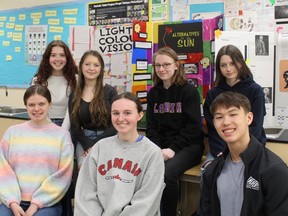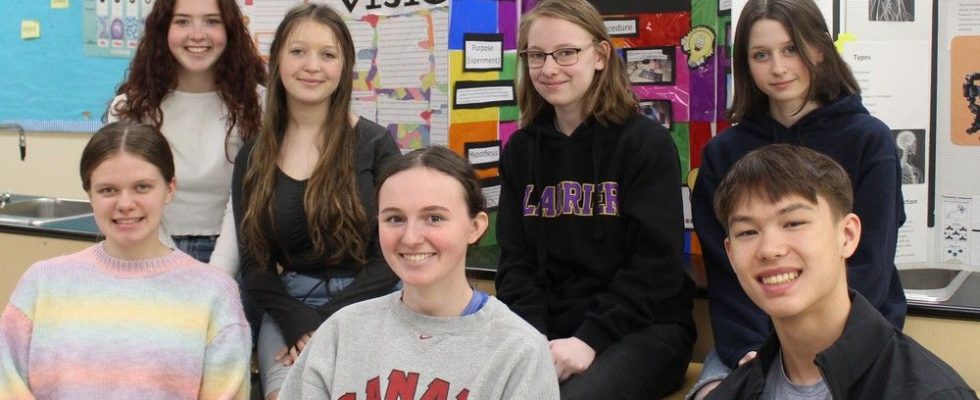
There wasn’t an erupting volcano or a potato battery in sight at the very first science fair organized and presented by students in the Laurier Program at Brantford Collegiate Institute.
Today’s students’ scientific research has become increasingly sophisticated, tackling environmental issues and health problems, and finding advanced ways to use technology.
“The process of collaborating, asking questions, piquing curiosity is so important,” said BCI teacher Emily Spicer, who assigned the inaugural fair to her students but left the planning up to them. “I was pleasantly surprised. The ones who did really well came for feedback. Even the night of the event, after getting suggestions from the audience, they’d adapt their work on the fly.”
Twenty-nine students enrolled in the Laurier Brantford program, some of them working in groups, produced 13 science fair entries, which were showcased to their peers during the school day and at an evening event, also student organized. The only requirement, said Spicer, was that the project be linked to one of their study units.
The BCI Laurier Program focuses on experiential learning in computer design and media, entrepreneurship, game design, and STEAM courses directly connected to Wilfrid Laurier University.
Grade 10 students Lillian Howard, Gabby Peterson and Emma Greig won the People’s Choice award for their project called Alternatives to the Sun, which investigated options for charging solar panels and the possibility of reusing light energy.
They researched their work for a couple of months, then spent two weeks experimenting using various colors of cellophane taped to a lamp to determine which color was most effective. Energy created in the solar panel was used to charge Howard’s cell phone.
“It’s about little things to help reduce energy,” said Greig.
Lights, Colours, Vision, a project created by Maggie Blevins, Hannah Kelly and Allison Stavnitzky, tied for second place among votes cast by visitors to the science fair.
Their work examined how artificial and natural light affects those who have color blindness and those with normal vision. Using volunteers to conduct their experiment, they determined that both groups could identify colors faster and more vibrantly in natural light.
“It was a really interesting topic to research,” said Blevins, who is considering a career in forensics.
Jack Tran worked solo on his project, which tied for second place in the People’s Choice vote. His project, Uncovering the Mysteries of Paralysis, has a personal connection. A family member suffers from a herniated disc.
Tran, who plans to be neurosurgeon, researched various experimental treatments for paralysis, including biomedical and stem cell therapy, and those that are conventional, such as physical therapy and medication.
“I like helping people,” said Tran. “Your brain’s doing all the work. If I help find what the problem is, that’s the best way I can help someone.”
Other science fair projects answered these questions: Does using a Rubik’s Cube improve short-term memory? Yes. And does eating a jalapeno help in lifting a heavier weight? Again, yes.
Spicer said the benefits of creating a hypothesis, collecting data, analyzing it and reaching a conclusion is an important learning process and she wants to make science fair participation a requirement for all BCI Grade 10 students.
A study done by the CD Howe Institute, a Canadian nonprofit policy research organization, determined that, due to digitalization across the economy and an aging population, Canada faces digital and STEM (science, technology, engineering and math) skills shortages, which can hurt businesses and affect economic growth.,
The federal government has put in place initiatives aimed at increasing science literacy and the participation of Canadians in STEM, including under-represented groups such as women and Indigenous communities.
Spicer said BCI runs a STEAM Club, which adds arts to the learning mix. Activities have included dissecting a squid, experimenting with robotics, and learning through school visits from a primatologist and those involved with the game design program at Laurier Brantford.
“We want students to consider career paths they may not have thought about,” said Spicer. “We’re constantly trying to give kids experiences beyond the classroom.”

Comments
Postmedia is committed to maintaining a lively but civil forum for discussion and encourages all readers to share their views on our articles. Comments may take up to an hour for moderation before appearing on the site. We ask you to keep your comments relevant and respectful. We have enabled email notifications—you will now receive an email if you receive a reply to your comment, there is an update to a comment thread you follow or if a user you follow comments. Visit our Community Guidelines for more information and details on how to adjust your email settings.
Join the Conversation